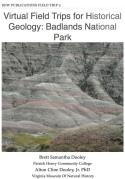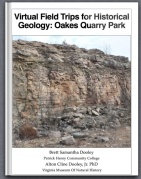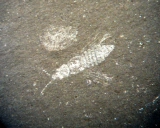One of the more intriguing fossils from the Triassic deposits at the Solite Quarry is the little diapsid reptile Mecistotrachelos apeoros, described by Fraser et al. (2007). There are only two known specimens of Mecistotrachelos (I have my doubts about a possible third specimen).
A particular feature of Solite vertebrates is that they are almost impossible to prepare, and in unweathered specimens they’re also really hard to see (black bone in a black slaty shale). Here is the holotype of Mecistotrachelos, photographed with a flash:
 You can certainly see that there’s a critter in there; the skull, neck, and elongate ribs are all visible. Even so, there’s not a lot of visible detail. The paratype specimen is even worse:
You can certainly see that there’s a critter in there; the skull, neck, and elongate ribs are all visible. Even so, there’s not a lot of visible detail. The paratype specimen is even worse:
 At the center of the image there’s a hint of some ribs. Part of the vertebral column is just visible as a line of bumps running diagonally from upper left to lower right, though the middle of the image.
At the center of the image there’s a hint of some ribs. Part of the vertebral column is just visible as a line of bumps running diagonally from upper left to lower right, though the middle of the image.
Preparing these specimens was hopeless, so we resorted to CT scans. They came out beautifully! Here’s a video slide show of the type specimen (actually the counterpart, and inverted from the image above):
(The bright round objects in the upper left about 3/4 of the way through the video are fish vertebrae; the elongate lump at the end is a coprolite.)
And the paratype:
Here are composite images based on the CT scans (in negative, to enhance details):

 Notice the nicely preserved forelimb tucked under the skull in the holotype, as well as the numerous fine teeth in both upper and lower jaws. The paratype has portions of both forelimbs as well as a hindlimb. The foot is in a rather unusual position, with the metatarsals at right angles to the tibia and the toes curled; we interpreted this as an adaptation for grasping small branches.
Notice the nicely preserved forelimb tucked under the skull in the holotype, as well as the numerous fine teeth in both upper and lower jaws. The paratype has portions of both forelimbs as well as a hindlimb. The foot is in a rather unusual position, with the metatarsals at right angles to the tibia and the toes curled; we interpreted this as an adaptation for grasping small branches.
The neck is remarkably long for a glider (the name Mecistotrachelos is a reference to this feature). The only other glider with a long neck is Sharovipteryx, but the neck in Mecistotrachelos is much longer.
The ribs themselves are also unusual when compared to other rib-gliders like Draco and Icarosaurus. Most gliders have ribs that are straight proximally and have a simple curve distally. These ribs seem to be used somewhat like a simple parachute.
In contrast, in Mecistotrachelos the ribs are curved proximally and have a compound curve (that is, they curve in at least two different planes) toward the tips. With the ribs all connected by a membrane, this means that any change in rib position (either fore-aft or up-down) would change the curvature of the wing, changing its lift and drag properties. Essentially, Mecistotrachelos may have had a variable-camber wing.
Moreover, the first two ribs on each side have greatly enlarged heads relative to the more posterior ribs. If the enlarged rib heads included muscle attachments, Mecistotrachelos would have been able to change the wing camber in flight, and differentially on opposite sides of the body. This potentially means that it could steer with some precision – a controlled glider living in the Triassic canopy. Was it just trying to avoid small tree limbs and branches, or was it actually catching insects in flight? (And, speaking of small limbs, that’s as far out on one as I’m willing to go!)
One other point that you might have noticed: the proportions of the two specimens are quite different. Relative to the size of the body, the holotype has a much larger skull, yet shorter forelimbs, than the paratype. We suggested in the description that this could indicate sexual dimorphism, but with a sample of two it’s hard to be certain.
As one final point of trivia, as far as I know this was the first new fossil taxon described entirely on the basis of CT scans.
Reference:











I forgot to mention that the type specimen of Mecistotrachelos is on exhibit at VMNH.
Also, I see that we’ve passed 20,000 page views. Did the 20,000th visitor take a screenshot of the counter reading 20,000, to win the contest?
Quite interesting.
Did the CT use x-rays? How do the x-rays change the visibility of fossils embedded in rocks?
The CT-scan does use X-rays. While the bones and sediment appear similar in visible light, they does not have the same opacity to X-rays (due largely, I think, to different densities); the differing opacities are what the scan is measuring.
So this is an example of how technology is changing/aiding paleontology (that you mentioned in our interview). Cool.
Have you found any other vertebrate fossils at Solite other than these reptile critters?
Yes, we’ve found lots of fish, and hundreds of Tanytrachelos. There are also hints of larger animals, including a possible phytosaur, and dinosaur tracks.